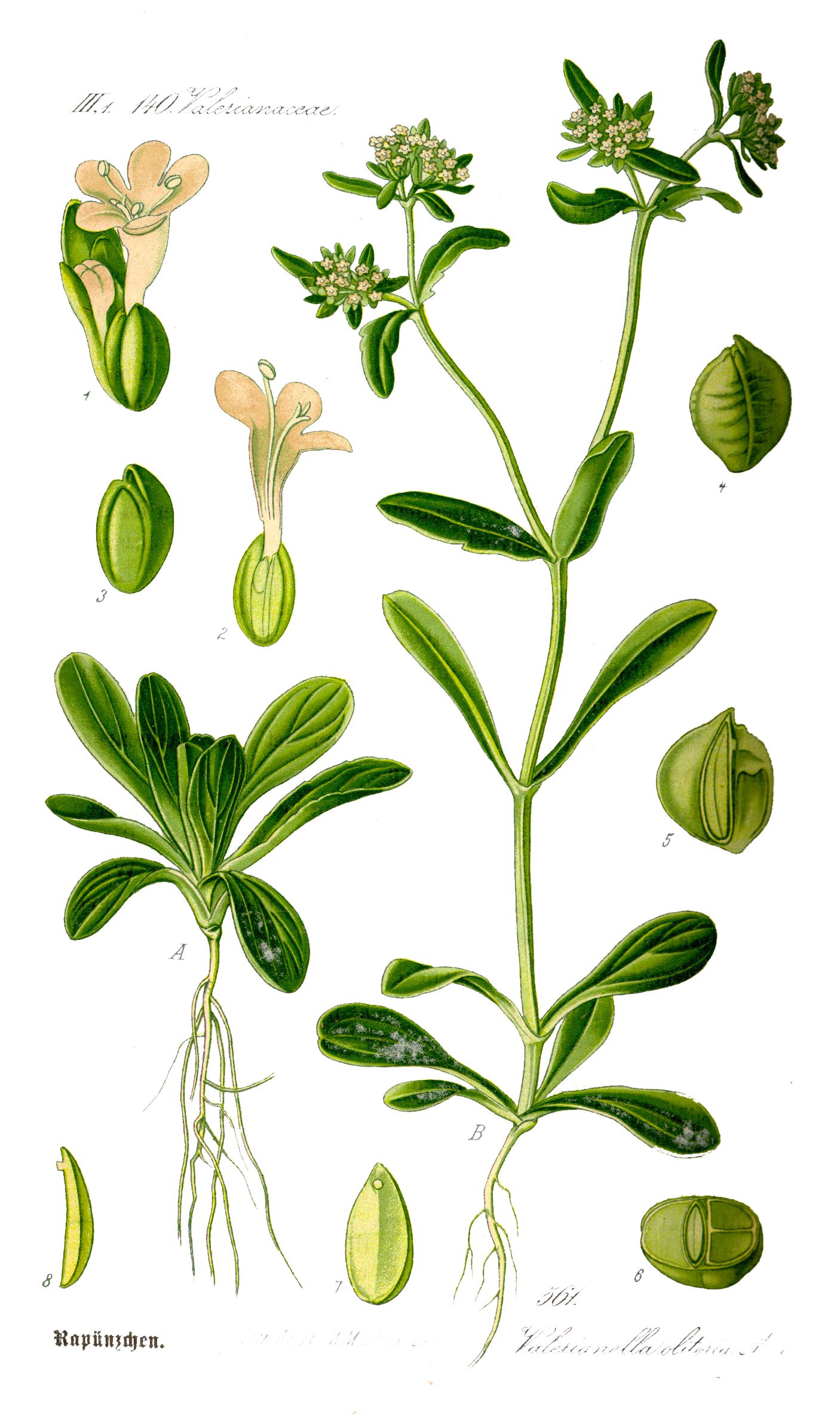Dies ist eine alte Version des Dokuments!
Valerianella locusta (L.) Laterr. - syn. Valerianella olitoria (L.) Pollich - Caprifoliaceae (also placed in Valerianaceae)
(common, European) cornsalad, lamb's lettuce, mâche, Feldsalat, Rapunzel, Rapünzchen
Annual herb, up to 30cm high, native to Europe, Western Asia and North Africa, naturalized elsewhere, cultivated as vegetable; stem hairy, branched; leaves basal and cauline, spathulate to narrowly elliptic-obovate, usually entire, 2-6cm long; flowers tiny, pale blue; fruit oblong-globose, 2mm, green.
http://www.nzflora.info/factsheet/Taxon/Valerianella_locusta.html
The young rosetta leaves are eaten as salad. They own a mild, slightly bitter taste and a green-nutty aroma.
„As a cultivated crop, it is a specialty of the region around Nantes, France, which is the primary source for mâche in Europe… The Brothers Grimm's tale Rapunzel may have taken its name from this plant, as the eponymous character is named for the „salad“ which her father has come into the sorceress' garden to steal. 'Rapunzel' is one of the German terms for corn salad.“
http://en.wikipedia.org/wiki/Valerianella_locusta
„Concentrates of blended lamb's lettuce obtained by combined high-vacuum distillation/solvent extraction were analysed by HRGC, HRGC-MS and, in part, HRGC-FTIR. In total, 103 aroma substances were identified for the first time. Qualitatively and quantitatively a number of 3-methylbutanoates [2-phenethyl-3-methylbutanoate, (E)-2-hexenyl-3-methylbutanoate, benzyl 3-methyl-butanoate, methyl 3-methyl-butanoate] and 2-phenethyl esters together with various volatile lipid cleavage products [(E)-2-hexenal, (E)-2-hexenol, (Z)-3-hexenal] were predominant.“
[Volatile constituents of Valerianella locusta., Götz-Schmidt, E.M., Schreier, P., Phytochemistry, Vol.27(3), 1988, 845-848]
„The advantages of this species are the short growing period of 60-90 days, low environmental requirements and high nutritional value of the crop. Previous analysis of lamb lettuce leaves for their food value
showed the contents 6.6% of dry matter, 1.8% protein, 0.36% fat, 1.4% sugars, 1.5% dietary fiber, 3.9 mg carotene, 35 mg vitamin C (Maly, 1998). It is also recognized as a rich source of potassium (420mg/100 g of fresh matter), phosphorus (49 mg), calcium (35 mg) and iron (2 mg)… Plants harvested in the spring season
contained higher levels of vitamin C [56-78mg%/34-56mg%], total sugars, K [5.0-6.8%/4.2-5.6%] and nitrates [0.20-0.25%/0.12-0.22%], whilst for those grown in autumn there were higher levels of dry matter, P and Mg [0.28-0.4%/0.41-0.45%].“
[Suitability of lamb lettuce cultivars for spring and autumn growing., Kolota, E., Adamczewska-Sowinska, K., In International Symposium on Sustainable Use of Plant Biodiversity to Promote New Opportunities for Horticultural Production 598, 2001, 255-257]
http://195.130.72.98/images/stories/acta/Acta%20598/598_38.pdf
„… lamb’s lettuce (Valerianella locusta) was chosen as a plant system, as it is rich in phenolic compounds and a steadily increasing consumer demand can be registered… Luteolin is one of the dominating compounds in lamb’s lettuce, while diosmetin appears in lesser amounts.“
[Surface morphology and chemical composition of lamb’s lettuce (Valerianella locusta) after exposure to a low-pressure oxygen plasma., Grzegorzewski, F., Rohn, S., Kroh, L. W., Geyer, M., Schlüter, O., Food chemistry, vol.122(4), 2010, 1145-1152]
Leaf samples of two cultivars (‘Gala’ and ‘Eurion’) of corn salad contained potassium 15-17g, calcium 2-3g, magnesium 0.7-1g, iron 72-88mg, and manganese 55-69mg per kg dry weight.
[Beneficial effects of silicon on hydroponically grown corn salad (Valerianella locusta (L.) Laterr) plants., Gottardi, S., Iacuzzo, F., Tomasi, N., Cortella, G., Manzocco, L., Pinton, R., Cesco, S., Plant Physiology and Biochemistry, Vol.56, 2012, 14-23]
„When compared to broccoli, lamb’s lettuce showed 3-fold higher total phenolic content as well as 4 to 22-fold
higher free radical scavenging activity. It has been shown that sonication effects made some barley cell walls break down, leading to the release of some bound phenolic compounds although in the present work it was not observed significant differences between ultrasound and gyratory shaker for both vegetables. The results presented herein clearly demonstrate that lamb’s lettuce must be regarded as a very interesting source of polyphenols, and thus a potential health-promoting food.“
[Phenolic Content and Antioxidant Activity Determination in Broccoli and Lamb’s Lettuce., Parente, C.P., Reis Lima, M.J., Teixeira-Lemos, E., Moreira, M.M., Barros, A.A., & Guido, L.F., Int J Agric Biosyst Sci Eng, Vol.7(7), 2013, 70-73]
http://www.waset.org/publications/16326

Thomé, O.W., Flora von Deutschland Österreich und der Schweiz, Tafeln, vol.4, t.561 (1885)
http://plantgenera.org/species.php?id_species=1050064
Valerianella locusta, Wien 2017; author: Rolf Marschner,
www.botanische-spaziergaenge.at
